Financial Capital
Strategy – Profitable Growth
Financial capital comprises the funds that are at the Group’s disposal that enabled its establishment by acquiring physical and human resources at the inception and its perpetuation by acting as a cushion for absorbing unforeseen losses as a going concern. It plays the primary roles of providing loans and investment opportunities for individuals, corporates, etc., safeguarding depositors, create value to shareholders, help promote the society and environment and keep a buffer for unforeseen losses. Financial capital has been acquired from external sources such as share capital and subordinated term debt as well as generated from internal sources such as retained profits and other revenue reserves. The Bank, and the Group have an extremely diverse range of operations to generate funds from. While nurturing traditional products, it is constantly innovating new products to cater to emerging needs and changing circumstances. Fund-based operations are judiciously managed to maintain satisfactory net interest margins. Simultaneously, through its dynamic capital markets cluster, it is constantly seeking to grow its share of fee-based income as a strategy for diversifying sources of income and managing capital. Costs too are rigorously controlled to keep profit margins, whilst not compromising on brand value.
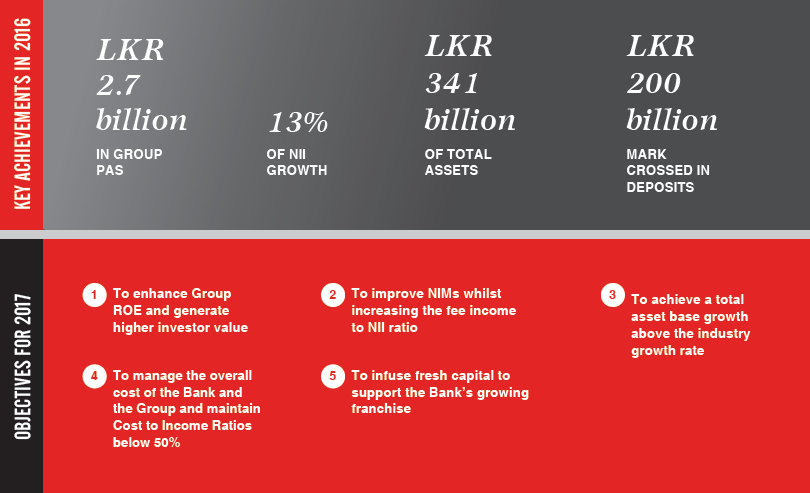
Financial Review
The year 2016 was marked by several monetary policy measures which impacted the banking and financial services industry. Liquidity, interest rates and demand for credit were the key variables which were impacted on by such policy measures which made performance during the year challenging for the banking industry.
Given below is a detailed analysis of how the Bank, its key business units and the group companies performed in generating and enhancing its financial capital.
The Financial Statements relevant to this discussion are available in the pages 282 to 402 of the Financial Reports section of this Report. Where applicable, extracts from the Financial Statements are presented alongside the discussion, and references are also made to Financial Notes, where further details of the items are given.
Profitability Analysis
Total Operating Income
|
Bank |
Group |
|
2016 |
2015 |
Change |
Change |
2016 |
2015 |
Change |
Change |
|
LKR '000 |
LKR '000 |
LKR '000 |
% |
LKR '000 |
LKR '000 |
LKR '000 |
% |
| Net-interest income |
8,487,312 |
7,521,823 |
965,489 |
13 |
8,860,769 |
7,807,377 |
1,053,392 |
13 |
| Non-interest income |
4,663,489 |
4,687,463 |
(23,974) |
(1) |
4,816,299 |
5,483,931 |
(667,632) |
(12) |
| Total operating income |
13,150,801 |
12,209,286 |
941,515 |
8 |
13,677,068 |
13,291,308 |
385,760 |
3 |
Total operating income for the Bank which comprised of net interest income and non-interest income increased by 8% in 2016 as compared to the previous year. Net interest income was the significant contributor towards this growth which highlights the growth recorded by the Bank in its core banking operations.
The total operating income for the Group was constrained to a growth of 3% due to the lower than expected performance of the group companies, as a result of the moderate capital markets activities experienced during the year.
The composition of Group total operating income for 2016 as compared with 2015 is depicted below.

Net Interest Income
|
Bank |
Group |
|
2016 |
2015 |
Change |
Change |
2016 |
2015 |
Change |
Change |
|
LKR '000 |
LKR '000 |
LKR '000 |
% |
LKR '000 |
LKR '000 |
LKR '000 |
% |
| Interest income – loans and receivables |
23,169,246 |
17,171,614 |
5,997,632 |
35 |
23,180,279 |
17,173,883 |
6,006,396 |
35 |
| Interest income – Placements and other investments |
5,449,001 |
3,996,234 |
1,452,767 |
36 |
5,780,327 |
4,258,049 |
1,522,278 |
36 |
| Total Interest Income |
28,618,247 |
21,167,848 |
7,450,399 |
35 |
28,960,606 |
21,431,932 |
7,528,674 |
35 |
| Interest expenses – Customer deposits |
12,362,362 |
8,157,526 |
4,204,836 |
52 |
12,331,264 |
8,137,635 |
4,193,629 |
52 |
| Interest expenses – Other borrowings |
7,768,573 |
5,488,499 |
2,280,074 |
42 |
7,768,573 |
5,486,920 |
2,281,653 |
42 |
| Total Interest Expenses |
20,130,935 |
13,646,025 |
6,484,910 |
48 |
20,099,837 |
13,624,555 |
6,475,282 |
48 |
| Net Interest Income |
8,487,312 |
7,521,823 |
965,489 |
13 |
8,860,769 |
7,807,377 |
1,053,392 |
13 |
| Net Interest Margin as a percentage of average total assets |
2.64% |
2.63% |
0.01% |
0 |
2.70% |
2.67% |
0.03% |
1 |
Net interest income (NII) of the Bank for 2016 was LKR 8,487 million and grew by 13% over the previous year. The growth in NII was supported by a 35% increase in interest income stemming from a gross loans and receivables base which stood at LKR 234 billion. The Bank largely benefited from the conscious asset re-pricing measures carried out during the year, with the upward movement in the interest rates. The Bank’s NII growth levels continue to be challenged due to the low CASA base of the Bank compared to the industry CASA base, which results in relatively high cost of funds for the Bank.
In this back drop, the Bank was able to defend its net interest margin (NIM), which is based on total average assets at 2.64% for the year, through effective management of the assets and liability portfolio.
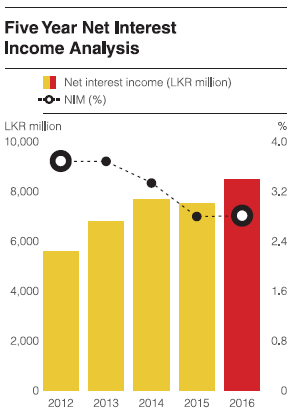
Non-Interest Income
|
Bank |
Group |
|
2016 |
2015 |
Change |
Change |
2016 |
2015 |
Change |
Change |
|
LKR '000 |
LKR '000 |
LKR '000 |
% |
LKR '000 |
LKR '000 |
LKR '000 |
% |
| Net fee and commission income |
2,253,226 |
2,016,260 |
236,966 |
12 |
3,046,132 |
3,156,841 |
(110,709) |
(4) |
| Net gains from trading |
982,123 |
1,088,464 |
(106,341) |
(10) |
982,123 |
1,088,464 |
(106,341) |
(10) |
| Net gains from financial investments |
211,370 |
262,048 |
(50,678) |
(19) |
440,748 |
493,739 |
(52,991) |
(11) |
| Other operating income |
1,216,770 |
1,320,691 |
(103,921) |
(8) |
347,296 |
744,887 |
(397,591) |
(53) |
Net fee and commission income, which forms a primary source of core banking income, grew by 12% over the previous year. This growth was mainly due to the increase in the volumes of the fee generating assets and liability portfolios of the Bank.
At a Group level, net fee and commission income was reduced by 4% over the year 2015. The Group’s capital markets cluster, which is primarily fee based businesses, recorded a negative growth in performance due to lower than expected capital markets activity experienced in the country during the year.
Net gains from trading was a 10% decline over the prior year. This income category records income from foreign exchange trading activities and was adversely affected by the low foreign exchange trading opportunities and restrictions that prevailed in the market during the year.
Net gains from financial investments which represent mark to market unrealized and realized gains and losses also recorded a negative growth of 19% over the prior year, primarily due to the increasing interest rate environment that prevailed during the year.
Please refer Note 08 of the Financial Reports section in page 307 for more details.
Other operating income of the Bank was LKR 1,217 million for the year and was a reduction of 8% over the previous year primarily due to the decreased exchange gains from revaluation of retained profits held in foreign currency during the year, as compared with the previous year. At a Group level the reduction in other operating income was 53%, which was due to capital gains realized by the Group on the divestment of its equity securities during the year 2015.
Please refer Note 09 of the Financial Reports section in page 307 for more details.
Impairment for Loans and Receivables and Other Losses
|
Bank |
Group |
|
2016 |
2015 |
Change |
Change |
2016 |
2015 |
Change |
Change |
|
LKR '000 |
LKR '000 |
LKR '000 |
% |
LKR '000 |
LKR '000 |
LKR '000 |
% |
| Impairment on individually significant loans |
1,116,072 |
526,932 |
589,140 |
112 |
1,116,072 |
526,932 |
589,140 |
112 |
| Impairment on collective loan portfolio |
277,097 |
150,673 |
126,424 |
84 |
277,097 |
150,673 |
126,424 |
84 |
| Capital write offs/ (recoveries) |
(14,483) |
34,228 |
(48,711) |
(142) |
(14,483) |
34,228 |
(48,711) |
(142) |
| Provisions/(reversals) of investments in subsidiaries |
(11,733) |
– |
(11,733) |
(100) |
45,887 |
34,312 |
11,575 |
34 |
| Total impairment for loans and receivables and other losses |
1,366,953 |
711,833 |
655,120 |
92 |
1,424,573 |
746,145 |
678,428 |
91 |
The Bank recorded an impairment charge of LKR 1,367 million for 2016. This compares with an impairment charge of LKR 712 million in 2015, an increase of 92%.
Impairment on individually significant loans increased by 112% whilst the impairment on collective loan portfolio increased by 84% to LKR 1,116 million and LKR 277 million respectively as compared with the prior year. The increase in the charge for impairment on individually significant loans during the year was mainly attributable to one-off specific provisions made for a few individually significant customers, based on sound judgment and objective evidence as per the Bank’s impairment policy. The increase in the impairment on collective loan portfolio was mainly due to the increase in the lending portfolio of LKR 19 billion over the previous year.
Percentage of impairment allowance against gross loans and receivables of the Bank was 2.58% as compared with 2.52% as at 31 December 2015.
| LKR million |
2016 |
2015 |
| Impairment allowance for loans and receivables to other customers |
6,039 |
5,410 |
| Gross loans and receivables to other customers |
233,679 |
215,012 |
| Percentage of impairment allowance (%) |
2.58 |
2.52 |
Improving the NII to
net fee and commission
income ratio is a key
priority for the Bank,
whilst harnessing
the cross selling
opportunities available
through the Group
companies.
Total Operating Expenses
|
Bank |
Group |
|
2016 |
2015 |
Change |
Change |
2016 |
2015 |
Change |
Change |
|
LKR '000 |
LKR '000 |
LKR '000 |
% |
LKR '000 |
LKR '000 |
LKR '000 |
% |
| Personnel expenses |
3,434,550 |
3,204,228 |
230,322 |
7 |
3,792,590 |
3,633,627 |
158,963 |
4 |
| Other expenses |
3,014,294 |
2,845,350 |
168,944 |
6 |
3,366,359 |
3,196,253 |
170,106 |
5 |
| Total operating expenses |
6,448,844 |
6,049,578 |
399,266 |
7 |
7,158,949 |
6,829,880 |
329,069 |
5 |
Total operating expenses of the Bank of LKR 6,449 million, grew by 7% whilst the Group total operating expenses of LKR 7,159 million grew by 5% over the prior year. Personnel expenses, which form the greater portion of total operating expenses, grew by 7% over the year. The increase in personnel expenses is due to the 7% increase in workforce of the Bank and the annual increments awarded to staff members. The Bank also increased its network by 11 branches during the year, which largely accounts for the increase in the workforce. At a Group level, the increase in operating expenses was only 5% due to the low scale of operations in the group companies compared to the previous year.
The reasonable growth levels in costs during the year 2016, affirms that ‘operational efficiency and cost optimization’, remain a key strategic focus of the Bank and the group companies in maximizing returns to shareholders.
Operating Efficiency
The cost to income ratio (CIR) of the Bank was 49.0% as compared to 49.6% for the year 2015. The Bank is still in an investment phase, targeting a higher market share. It is expected that the Bank’s CIR would improve
with the relatively new branches of the Bank improving their efficiency levels within the next few years. The average break-even duration for a new branch is approximately 18 months to 24 months. Depicted is a trend of the composition of key costs of the Bank and the CIR over the past five years.
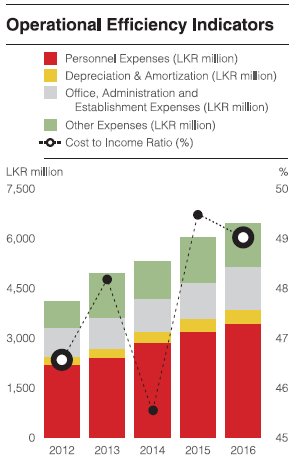
Profit Before Taxation
The Bank’s profit before tax on financial services of LKR 5,335 million, declined by 2% over the prior year. The negative variance was primarily due to the higher impairment provisions made during the year compared to the prior year.
Higher impairment provisions, together with the less than anticipated performance of group companies resulted in the Group profit before tax on Financial Services of LKR 5,094 million declining by 11% over the prior year.
Profit Attributable to Shareholders (PAS)
Group PAS for the year was LKR 2,691 million, a reduction of 24% over the prior year due to the key reasons explained above. The composition of banking profits and the profits from group companies are depicted below. The improvement in banking profits was a result of increase in scale of operations during the year coupled with sustained interest margins and effective cost management.
|
2016 |
2015 |
| PAS – Banking operations contribution |
81% |
74% |
| PAS – Group companies contribution |
19% |
26% |
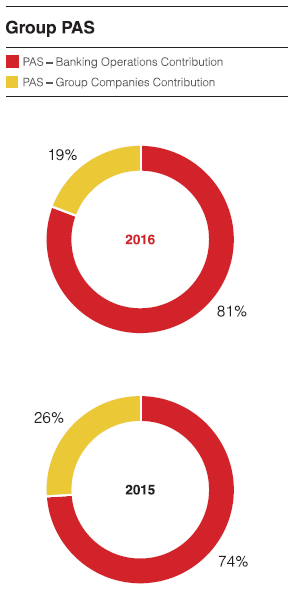
Total Comprehensive Income for the Year
|
Bank |
Group |
|
2016 |
2015 |
Change |
Change |
2016 |
2015 |
Change |
Change |
|
LKR '000 |
LKR '000 |
LKR '000 |
% |
LKR '000 |
LKR '000 |
LKR '000 |
% |
| Profit for the year |
3,170,271 |
3,511,431 |
(341,160) |
(10) |
2,814,959 |
3,670,095 |
(855,136) |
(23) |
| Total other comprehensive income |
(475,083) |
(513,191) |
38,108 |
(7) |
(496,504) |
(385,936) |
(110,568) |
29 |
| Total comprehensive income for the year |
2,695,188 |
2,998,240 |
(303,052) |
(10) |
2,318,455 |
3,284,159 |
(965,704) |
(29) |
The total other comprehensive income was a loss of LKR 475 million as compared to a loss of LKR 513 million for the prior year. The losses are primarily due to the mark to market unrealized losses on the Bank’s investment portfolio classified as ’Available-for-Sale‘. These investments are maintained for liquidity purposes and have positively contributed to net interest income due to increasing interest rate environment experienced during the year.
Accordingly the total comprehensive income for the year for the Bank and the Group was LKR 2,695 million and LKR 2,318 million respectively.
Balance Sheet Analysis
|
Bank |
Group |
|
2016 |
2015 |
Change |
Change |
2016 |
2015 |
Change |
Change |
|
LKR '000 |
LKR '000 |
LKR '000 |
% |
LKR '000 |
LKR '000 |
LKR '000 |
% |
| Total assets |
334,544,735 |
309,157,605 |
25,387,130 |
8 |
340,731,768 |
315,353,733 |
25,378,035 |
8 |
| Loans and receivables |
227,639,844 |
209,602,069 |
18,037,775 |
9 |
227,679,939 |
209,665,561 |
18,014,378 |
9 |
| Investments |
80,597,224 |
73,876,707 |
6,720,517 |
9 |
84,436,804 |
77,257,188 |
7,179,616 |
9 |
| Total liabilities |
309,799,685 |
286,456,747 |
23,342,938 |
8 |
309,718,472 |
285,953,016 |
23,765,456 |
8 |
| Customer deposits |
203,866,547 |
184,933,230 |
18,933,317 |
10 |
203,515,828 |
184,152,280 |
19,363,548 |
11 |
| Debt securities issued and other borrowed funds |
59,233,264 |
60,527,844 |
(1,294,580) |
(2) |
59,233,264 |
60,497,844 |
(1,264,580) |
(2) |
| Subordinated term debts |
19,446,501 |
19,573,883 |
(127,382) |
(1) |
19,446,501 |
19,573,883 |
(127,382) |
(1) |
| Total equity to equity holders of the Bank |
24,745,050 |
22,700,858 |
2,044,192 |
9 |
29,936,587 |
28,382,204 |
1,554,383 |
5 |
Total Assets
Total assets of the Bank reached LKR 334 billion, an increase of LKR 25 billion (or 8%) over the prior year. Assets growth for the year was somewhat slower compared to prior years. However, moderated asset growth was anticipated for 2016 in the aftermath of an aggressive asset growth achieved by the Bank of 18% and 31% in 2015 and 2014 respectively.
Return on assets (ROA) of the Bank for 2016 was 1%. This in part reflects the deployment of the Bank’s assets in generating returns to our shareholders. The Bank is focused on increasing its ROA to over 1.5% levels.
The Group total assets also grew by 8% to reach LKR 341 billion over the prior year, with total assests of the group companies contributing LKR 6 billion as at 31 December 2016.
Loans and Receivables
Loans and receivables of the Bank, after setting off impairment allowances as at end 2016, was LKR 228 billion, a 9% growth over the prior year. The growth in loans and receivables was also moderated during 2016 (compared to the 20% increase recorded in 2015 and 28% in 2014) partially due to the constrained liquidity position which the market faced during the year. On the other hand, the Bank has been managing its balance sheet structure and funding options, under which the loans and receivables growth is commensurate to the growth on deposits.
The Bank continues to draw strength from its deep rooted competencies in project financing, as reflected in the growth in the PIF portfolio. The relatively low growth reported by the corporate banking portfolio is a reflection of the intended strategy of the Bank where the focus is shifted towards expanding the retail and SME portfolio.
On a product base analysis of the loans and receivables, the key contributors for the portfolio growth was long-term loans, overdrafts, trade finance loans and housing loans.
Further analysis on the loans and receivables can be found in Note 25 – Loans and Receivables to Other Customers in page 322 under Financial Reports and in Credit Risk Analytics in page 165 under the Risk Management Report.
Asset Quality
Asset quality as measured by the gross non-performing loan (NPL) ratio was 2.63% as at 31 December 2016. The well-maintained asset quality of the Bank is a result of the strong loan reviewing, monitoring and recovering process of the Bank, which the Bank has perfected over the years.
The NPL ratio of the Bank has historically been below that of the industry.
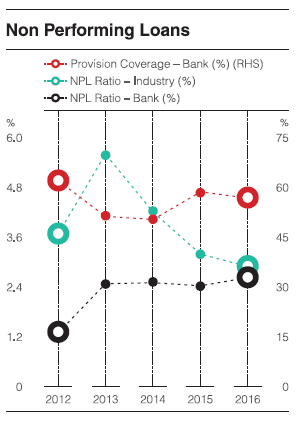
Customer Deposits
The Bank’s customer deposits grew by 10% over the prior year, reaching LKR 204 billion, and crossing the LKR 200 billion mark for the first time in the Bank’s history. This landmark in customer deposits was achieved by the Bank in a gratifyingly short period of just over 10 years, since the Bank attained commercial banking status in 2005.
Within the total customer deposits, the rupee deposit base accounted for 78% and the foreign currency deposit base accounted for 22% as compared to 72% and 28% respectively as at 31 December 2015. The positive shift in the rupee deposit base is in line with the Bank’s expanding branch network.
The CASA ratio for the Bank was 22.7% and is relatively low compared to the banking industry averages.
Increasing the Bank’s CASA ratio from its current level is a key strategic priority for the Bank. Improving CASA remains a challenge to the Bank as well as the industry at large in an increasing interest rate environment, as depositors’ preference largely skews towards time deposits. This skewness is further augmented by the considerable interest rate gap that prevails between the savings and time deposits in the Sri Lankan banking and non-banking sphere, which will also pressurize the NIMs in the industry.
More details on customer deposits are available on Note 37 – Due to other customers in page 341 under Financial Reports section.
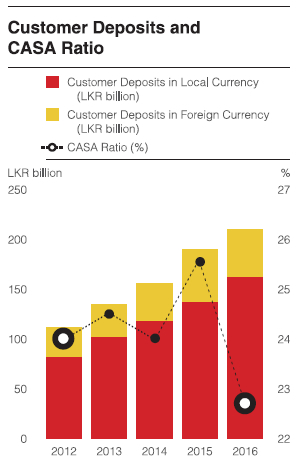
Capital Adequacy
|
Bank |
Group |
|
2016 |
2015 |
2016 |
2015 |
| Eligible Tier I capital – LKR million |
22,404 |
20,018 |
29,108 |
27,154 |
| Eligible Tier II capital – LKR million |
8,749 |
9,596 |
9,376 |
10,262 |
| Capital base (Tier I + Tier II) – LKR million |
31,153 |
29,614 |
38,484 |
37,416 |
| Tier I capital adequacy ratio (%) |
9.31 |
8.51 |
11.55 |
11.07 |
| Tier I & II capital adequacy ratio (%) |
12.95 |
12.59 |
15.27 |
15.25 |
Bank's Tier I capital adequacy ratio for 2016 was 9.31% whilst its total capital adequacy ratio was 12.95%. The same ratios for the Group were 11.55% and 15.27% respectively and are well above the regulatory minimum levels of 5% and 10% respectively, as specified by the Central Bank of Sri Lanka. The Bank is preparing for the migration to the BASEL III compliance requirement in July 2017. In this preparation process, infusion of fresh capital to support the Bank’s growing franchise is a key strategic priority, which the Bank will pursue during 2017.
Currently, the Bank remains well within the new regulation requirement proposed by the Fiscal Budget of the Government for 2017 on the minimum capital of commercial banks of LKR 20 billion.
Please refer pages 186 to 189 under the Risk Management Report for a detailed calculation of the Bank’s and Group’s capital adequacy levels.
Liquidity
The Bank maintained its liquidity levels well above the statutory requirements during the year. In addition, the Bank maintains liquidity levels to meet the customers’ demands for deposits at any given point of time. Liquid assets are deployed, taking into account the profitability implications as well.
The statutory liquid ratios for DBU and FCBU were 21.50% and 22.93% respectively as at 31 December 2016 and were well above the minimum regulatory requirement of 20%.
The Bank also maintains the Liquidity Coverage ratio stipulated under BASEL III guidelines which was, 125.63% for all currency liquidity and 142.53% for the rupee liquidity as at 31 December 2016. The ratios are well within the minimum stipulated ratio of 70% for the year 2016.
Total Shareholder Returns
Total shareholder equity comprising of capital, statutory reserve fund, retained earnings and other reserves as at end 2016 was LKR 24.7 billion at the Bank level and LKR 30.0 billion at the Group level. The Bank’s shareholder equity recorded a 9% growth over the prior year. The movement in same can be further analyzed by referring the Statement of Changes in Equity available in the pages 290 to 293 of the Financial Reports section.
The Bank’s return on average shareholders' funds (ROE) for the year ended 31 December 2016 was 13.36% with earnings per share (EPS) of LKR 19.19. The same measures for the Group were 9.23% and LKR 16.29 respectively.
Share Price and Market Capitalization
The NDB share closed trading at LKR 156.00 at the end of the year and the Market Capitalization was LKR 25.8 billion.
Please refer pages 128 to 150 under the Investor Relations for a detailed analysis of the performance of the Bank’s share and other the key investor performance indicators during the year 2016.
Improving the NII to net fee and commission income ratio is a key priority for the Bank, whilst harnessing the cross selling opportunities available through the Group companies.
Economic Value Added
Economic value defined: Economic Value Addition (EVA) is the excess value created over the required return of the Bank’s investors who comprise shareholders and debtholders. EVA is a measurement of profit distinct from that of financial profit.
| For the year ended 31 December |
2016 |
2015 |
2014 |
2013* |
2012 |
|
LKR million |
LKR million |
LKR million |
LKR million |
LKR million |
| Invested equity |
|
|
|
|
|
| Total equity |
24,745 |
22,701 |
22,238 |
19,620 |
14,942 |
| Add: Allowance for impairment charges for loans and receivable and other losses |
6,134 |
5,517 |
5,121 |
4,379 |
2,972 |
| Total |
30,879 |
28,218 |
27,359 |
23,999 |
17,914 |
| Earnings |
|
|
|
|
|
| Profit after tax and dividend on preference shares |
3,170 |
3,511 |
3,418 |
7,723 |
2,924 |
| Add: Impairment for loans and receivables and other losses |
1,367 |
712 |
566 |
1,238 |
106 |
| Less: Loan losses written off |
14 |
(34) |
(64) |
(76) |
(67) |
| Total |
4,551 |
4,189 |
3,920 |
8,885 |
2,963 |
| Cost of equity (Based on 12 months weighted average T-bill rate plus 2% for risk premium) |
11.94% |
8.63% |
10.24% |
12.63% |
14.02% |
| Cost of average equity |
3,528 |
2,398 |
2,630 |
2,647 |
2,357 |
| Economic value added |
1,023 |
1,791 |
1,291 |
6,238 |
607 |
*The one-off equity income of LKR 6,031 million in 2013 is included.
Financial Value Added
The Bank creates value through the banking and non-banking activities that it carries out. After the cost of services and impairment charges for loans and receivables, the remaining value is available for distribution to the key stakeholder groups that partner with the Bank. A portion of the value created is retained within the Bank to be invested for expansion and growth.
| For the year ended 31 December |
2016 |
2015 |
2014 |
2013 |
2012 |
|
LKR million |
Change
% |
LKR million |
Change
% |
LKR million |
Change
% |
LKR million |
Change
% |
LKR million |
Change
% |
| Value added |
|
|
|
|
|
|
|
|
|
|
| Income from banking services |
32,290 |
|
24,924 |
|
24,518 |
|
23,556 |
|
19,448 |
|
| Cost of services |
(20,399) |
|
(14,250) |
|
(13,998) |
|
(15,858) |
|
(13,038) |
|
| Value added by banking services |
11,891 |
|
10,674 |
|
10,520 |
|
7,698 |
|
6,410 |
|
| Non-banking income |
992 |
|
931 |
|
444 |
|
6,100 |
|
754 |
|
| Impairment for loans and receivables and other losses |
(1,367) |
|
(712) |
|
(566) |
|
(1,238) |
|
(106) |
|
| Total |
11,516 |
|
10,893 |
|
10,398 |
|
12,560 |
|
7,058 |
|
| Distribution of value added |
|
|
|
|
|
|
|
|
|
|
| To employees |
|
|
|
|
|
|
|
|
|
|
| Salaries and other benefits |
3,435 |
30 |
3,204 |
29 |
2,873 |
28 |
2,389 |
19 |
2,173 |
31 |
| To providers of capital |
|
|
|
|
|
|
|
|
|
|
| Dividends to equity holders |
654 |
|
1,815 |
|
1,978 |
|
3,222 |
|
657 |
|
| Interest to debenture holders |
2,255 |
|
1,840 |
|
1,378 |
|
95 |
|
– |
|
| Total to providers of capital |
2,909 |
25 |
3,655 |
34 |
3,356 |
32 |
3,317 |
26 |
657 |
9 |
| To Government |
|
|
|
|
|
|
|
|
|
|
| Income tax |
1,003 |
|
872 |
|
1,213 |
|
854 |
|
1,023 |
|
| Financial Services VAT |
904 |
|
770 |
|
882 |
|
911 |
|
622 |
|
| Nation Building Tax |
144 |
|
140 |
|
147 |
|
– |
|
– |
|
| Corporate Insurance Levy |
30 |
|
23 |
|
24 |
|
77 |
|
– |
|
| Super gain tax |
– |
|
732 |
|
– |
|
– |
|
– |
|
| Total Government |
2,081 |
18 |
2,537 |
23 |
2,266 |
22 |
1,842 |
15 |
1,645 |
23 |
| For expansion and growth |
|
|
|
|
|
|
|
|
|
|
| Retained profit |
2,516 |
|
964 |
|
1,440 |
|
4,501 |
|
2,267 |
|
| Depreciation/amortization |
435 |
|
370 |
|
323 |
|
302 |
|
265 |
|
| Deferred taxation |
113 |
|
154 |
|
127 |
|
194 |
|
38 |
|
| Total for expansion and growth |
3,065 |
27 |
1,488 |
14 |
1,890 |
18 |
4,997 |
40 |
2,570 |
36 |
| To community investments |
|
|
|
|
|
|
|
|
|
|
| Donations |
27 |
|
8 |
|
13 |
|
14 |
|
13 |
|
| Total to community |
27 |
0 |
8 |
0 |
13 |
0 |
14 |
0 |
13 |
1 |
| Total distributed |
11,516 |
100 |
10,893 |
100 |
10,398 |
100 |
12,560 |
100 |
7,058 |
100 |
Our well diversified customer base is served through an amalgam of dedicated and specialized business units. The contribution of the business units to the overall performance of the Bank are discussed in the section that follows.
Performance of Business Units
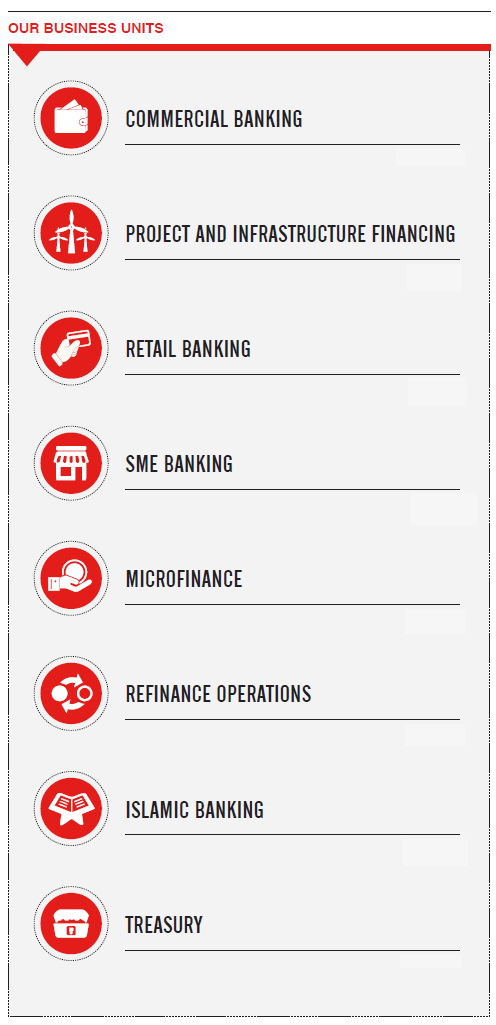

Commercial Banking
The Corporate Banking Division, which contributes 55.4% of the Bank’s asset base and 25.8% of its net revenue, encapsulates two main arms, development banking and commercial banking. The services offered, which include a wide range of products, are targeted to satisfy both the short and long-term needs of corporate customers. The focus of the development banking activities is mainly on project and infrastructure financing.
Strategic Focus
The commercial banking arm specializes in providing working capital solutions to the large and medium size corporate enterprises, and the Bank has evolved in a short span of time to become one of the major players in this domain. The expertise the Bank has built-up in commercial banking, project and infrastructure financing, cash management coupled with Islamic Banking has positioned it to offer a unique selling proposition in these lines of business. The unit has also supported Sri Lankan companies to venture overseas including countries such as Maldives, Cambodia, Bangladesh and Uganda.
The Bank always endeavours to align its policies with national growth strategies. Accordingly the Bank’s commercial lending during the year was concentrated in sectors such as construction/property development, agriculture (including tea, paddy and related crops), Business Process Outsourcing (BPO) and tourism. However, we did not confine our lending to the large and medium sectors. By facilitating solutions down the entire value chain, through the Distributor Financing and Supplier Financing portfolio, our branch network was able to indirectly reach the rural sector.
Performance
In today’s fast moving commercial environment the needs of customers are also dynamic. The Commercial Banking Unit, while maintaining traditional products, has to constantly innovate to keep pace. Products include import and export, guarantees, overdraft, short-term loans and advanced treasury products. During the year the Unit’s highly qualified and professional management team, whose skills were topped up with our seamless processes, were able to consolidate the existing portfolio and selectively acquire new customers.
During the year the Bank had to contend with severe competition, not to mention the challenging economic and political environment. In this context, the strategic challenge for the division was to strengthen the relationships while adapting to the changes in the external environment. Despite the unfavourable milieu, the Division was able to consolidate the portfolio and improve profitability. The net interest margins remained stable and fee based income recorded 33% of net revenue which helped sustain overall profitability.
There is a fairly equitable balance in the Corporate Banking asset portfolio between foreign and local currency loans and advances. Declining exports in the apparel industry, the EU ban on Sri Lankan seafood and drop in tea production adversely affected exports. The Commercial Banking asset portfolio was rationalized during the year, whilst its own liability portfolio accounting for 54% of its funding requirement. The CASA ratio was maintained at a very commendable level of 28.2%. The Unit’s revenue recorded modest growth of 8% in 2016.
| KPI |
2016
LKR million |
2015
LKR million |
YoY Change |
| Total operating income |
3,047 |
2,816 |
8% |
| Profit before tax |
1,375 |
968 |
42% |
| Profit after tax |
812 |
581 |
40% |
| Non-performing loans |
2,039 |
2,081 |
-2% |
| Cost to income ratio |
27.9% |
27.7% |
– |
| Total loans and receivables |
74,483 |
78,884 |
-6% |
An unfortunate result of the adverse macroeconomic factors has been that our Commercial Banking non-performing loan (NPL) ratio marginally increased to 2.7% from 2.6% in 2015. However, despite this, the NPL percentage remains within acceptable industry standards. It is noteworthy that the NPL ratio of our Commercial Banking portfolio has shown a healthy average of below 3% for over five years. Excellent credit origination methods and proactive administration procedures have helped mitigate the impact of an adverse environment. Adaptation of LKAS 36 on ‘Impairment of Assets’ on a monthly basis has also helped in timely identification of vulnerable situations and taking remedial actions when required.
Outlook
Along with the overall financial services sector of the country the Bank seeks to adapt its business model to accommodate the changes that took place in the micro as well as the macro environment.
We wish to capitalize on the opportunities in growth sectors such as logistics, construction, tourism and agro business which have been bolstered by concessions granted to these sectors in the 2017 Budget and Government Policy. Revised economic policies of the Government and the more favourable climate regarding international relations
have opened up opportunities for off shore lending and attracting more foreign direct investments (FDI) into the country. The present trend of diminishing interest rates and net interest margins being squeezed as a result, makes it imperative to boost fee based income.
Geared by ISO 9001: 2008-Certified Corporate Banking and Trade Finance Departments, growing portfolio of Islamic Banking business, an electronic banking system leveraging cutting edge technology and an expanded correspondent banking network the Bank's Commercial Banking business looks forward to 2017 with optimism.
Cash Management Unit
Towards the end of year 2015, Cash Management unit was repositioned within the Corporate Banking unit in order to further strengthen the corporate transaction business, whilst continuing to provide its services to the Retail & SME and the Bank’s subsidiaries for domestic and cross border payments.
The scope of the Cash Management unit covers the areas of corporate electronic banking, managing of Corporates, financial and institutional relationships, the Chinese Desk and the collection & payments of capital market transactions.
The online banking platform has been further upgraded to serve its Corporate and SME clients to better manage their payments and documentary credits electronically, during the year 2016. As a result of these efforts, during 2016 the Bank was successful in increasing its Corporate Electronic Banking network by over 42%, with a throughput increase in transactions by 36%. We anticipate this trend to continue and the electronic banking delivery will be a key element of our strategy in ‘brick walling’ our clients and attracting new clients.
Further the unit was able to execute many Escrow deals during the year 2016.
During the year, the Cash Management Unit successfully tied up with the EPF Department for straight through EPF settlement. This enabled the Corporates to settle their EPF payments online. EPF Settlement System (ESS) has been fully integrated with the online web services of the EPF department of the Central Bank of Sri Lanka; the Bank has achieved another milestone as the first bank in Sri Lanka to implement the fully online integrated system for EPF.
In the year 2016, the Cash Management Unit continued to serve as the banker for many capital market transactions.
Further, the unit has been able to strengthen its Chinese business arm and penetrate many of the large to small business entities of the Chinese business segment. The Chinese desk exclusively caters to multiple banking needs of the Chinese business community and has managed to create a unique value proposition in order to capture Chinese industry giants. Significant revenue growth has been recorded along with high customer acquisition.

Project and Infrastructure Financing
Strategic Focus
The Project and Infrastructure Finance Division (PIF) executed some key strategic initiatives during 2016 and was able to reap the results during the year. Consolidating the path followed in 2015, the division focused on achieving a profitable balance sheet growth through off shore lending to overseas projects of both Sri Lankan companies and overseas companies. In addition it sought to diversify the portfolio into growth sectors such as construction and power and energy. The focus on domestically funded infrastructure projects was also continued.
Despite constraints arisen from restricted liquidity in the banking system resulting in increasing the cost of funds and stiff competition from other banks offering project financing, PIF achieved an impressive asset growth of 20% during the year. With the rising interest rates during the year, coupled with variable interest rates on assets, PIF division was able to achieve a higher revenue in 2016.
Key Strengths
From its inception, PIF has built trusting and long lasting relationships with its clients through a deep understanding of their business needs. The unit is driven by multi-disciplinary professionals who are well-qualified and experienced. Our organizational knowledge, built over the years through experience in various industries and overseas countries makes NDB PIF the financial partner of choice for companies who are looking for long-term financing. In addition to our core products, we also offer our customers advisory services in legal and certain technical aspects making the Bank's PIF unit, not a mere financier but a valued partner.
Performance
Key outcomes as at end December 2016 of the above strategic initiatives ensured that the unit achieved the following growth.
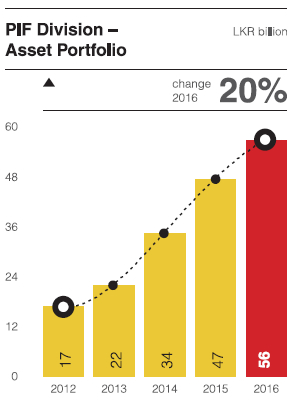
PIF has sustained a healthy growth in asset portfolio in the last three consecutive years, recording a compounded annual growth rate of 37% which is remarkably above the industry growth rate.
For the second consecutive year PIF has won the award for ‘The Best Domestic Project Finance Bank of the Year’ at Asian Banking and Finance, Wholesale Banking Awards ceremony. This is a tribute to the role the Bank has played in the Project and Infrastructure Financing arena and shows that it is well positioned to become a dominant player in the Sri Lankan long-term financial services market.
Products on Offer
The Bank's PIF division offers the following long-term financial solutions to its customers.
- Long-Term Loans (in both LKR and Foreign Currencies)
- Islamic Banking Long-term financing products (in both LKR and Foreign Currencies)
- Lease Facilities for Corporates
- Securitization of Future Tea Sales
- Securitization of Lease and Hire Purchase Receivables
- Investments in Listed Rated Debentures
- Investments in Listed Preference Shares
- Offering services as Arranger, Lead Bank in syndications
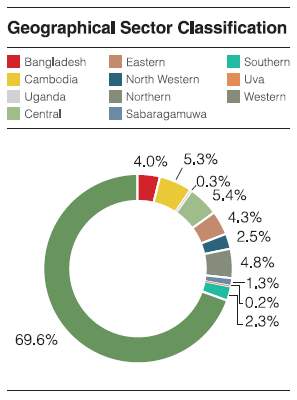
Overseas lending activities have contributed to 9.6% of the total assets of the PIF as at 31 December 2016.

PIF – KPIs
| KPI |
2016 |
2015 |
YoY Change |
|
LKR million |
LKR million |
% |
| Total operating income |
815 |
719 |
13 |
| Profit before tax |
178** |
642* |
-72 |
| Profit after tax |
136 |
407 |
-67 |
| Non-performing Assets |
862 |
176 |
390 |
| Cost to income ratio |
37% |
38% |
– |
| Total loans and receivables (Including Investments) |
55,909 |
46,709 |
20 |
*Includes a provision reversal of LKR 196 million
**Resultant of provisions of LKR 336 million
NPL Situation weakened due to two instances of company specific issues.
Achievements in Year 2016
PIF's major achievements in the year 2016 were:
- Acted as the lead bank for a syndicated facility to finance the development of a major mixed development project, which will greatly enhance the skyline of Colombo in the years to come.
- Spearheaded financing Sri Lankan companies investing in overseas energy projects, particularly in the East African region, by approving a facility to a mini hydro power project in Uganda. This was also in line with the Bank’s emphasis on renewable sources in power generation
- Approved facilities to Cambodian financial institutions
The Bank wishes to place emphasis on the alternative renewable sector in power generation and has been working closely with its customers on a number of renewable energy projects locally but importantly in the East African region.
Outlook
Low net interest margins have created a need to improve the percentage of fee based income and tight controlling of costs. Further there is a need to source funds to match long tenure accommodations. PIF recognizing these opportunities in adversity, proposes to face the challenge by exploring high yielding lending opportunities, enabling it to maintain the asset growth momentum of the past.
PIF will also continue to explore new avenues in the domestic market in order to grow the asset portfolio. In line with its environmental consciousness, PIF intends to continue financing power projects that utilize renewable sources, thereby minimizing carbon footprint.

Retail Banking
The Bank has evolved from being a predominantly development bank prior to 2005, to also being a robust retail bank which it is today. The Bank’s personal loan product, 'Dream Maker', has been a major driver in this process, and has secured the leading position in the market. Overall, the Bank has also secured a commendable share of the retail banking market.
Strategic Focus
To increase the Bank’s reach by the widening of the Branch Network, broad basing retail banking, increased cross selling and promoting products. To further push e-statement and mobile banking to keep the Bank abreast in this digital era.
Performance
During the year under review the retail banking assets remained flat at LKR 54 billion which is a marginal drop from LKR 55 billion in 2015. This has been achieved despite strong loan recoveries in excess of LKR 12 billion during the year. The overall assets were hampered by an increase in interest rates, and the consequent drop in lending. The personal loan product Dream Maker Loans (DML), accounted for 39% and the largest share of the Bank’s retail asset portfolio and had a healthy NPL ratio of 1.56%. Leasing accounted for 33% and had the second largest share with a NPL ratio of 2.31% while housing loans was in third place with 18% and 1.2% respectively.
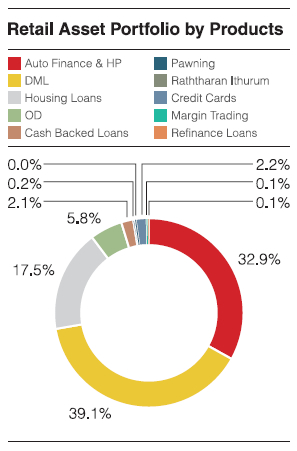
The Bank’s deposit rates in the first half of the year were adversely affected by the low interest rates in the market. Even though the deposits picked up in the latter part of the year with the increase in term deposit rates the growth momentum that was hoped for could not be achieved. At the end of 2016 a growth of 23% has been recorded mainly through the term deposits.
Retail Banking – KPIs
|
2016 |
2015 |
YoY Change |
| KPI |
LKR million |
LKR million |
% |
| Total operating income |
4,293 |
3,574 |
20 |
| Profit before tax |
252 |
17 |
1,423 |
| Profit after tax |
145 |
10 |
1,363 |
| Non-performing loans |
978 |
991 |
-1 |
| Cost to income ratio |
91% |
102% |
– |
| Total loans and receivables |
53,497 |
55,140 |
-3 |
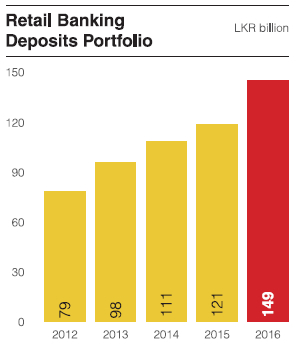
The CASA numbers remain the same; however a drop in the ratio is attributable to the rapid increase in term deposits when compared to the last quarter of 2015.
Outlook
The retail banking outlook for the Bank remains strong with the Bank identifying growth opportunities in credit cards and mobile banking which will compliment the strong franchises in leasing, personal loans and housing. Consequently the Bank is expected to significantly improve its margins and fee income.
The Bank is also focussing in improving its deposit and CASA base using the branch network and new product developments.
Retail Banking – Alternate Channels
Strategic Focus
The alternate channels team was established with a view to porting the conventional banking arena to a digital platform. This initiative has been very successful with the team driving the innovative products and penetrating the emerging market space of e-commerce.
Performance
Mobile Banking
The Bank has broken into the local e-commerce market with its innovative mobile banking solution. This revolutionary application features a multitude of user friendly payment modes and trailblazing features giving it a unique selling point in the financial services industry. The value addition the Bank has achieved by this application is passed onto customers of varying social levels.
The mobile banking app is also referred to as 'shake banking', given various options it make available to the user, at the shake of the phone. This has become increasingly popular due to its convenience as well as its entertainment aspect. At the South Asian Excellence Awards where the Bank won awards for ‘Best Use of Mobile Technology in the Banking Sector’ and ‘Best Use of Mobile Technology in Financial Services’, the unique selling points of our mobile products were recognized. Further the app was bestowed ‘The Most Admired Mobile App’ by the Asia Pacific Customer engagement forum; endorsing the giant leap it has achieved in its digital journey.
E-statements
Routine banking procedures have also been upgraded through technology. Bank statements have been converted into the individual and corporate ‘life style e-statements’ which are smart interactive e-statements.
Off-Site ATMs
The Bank has increased customer accessibility by positioning ATMs at strategic locations in the suburbs, while delivering additional touch points to the existing customer base. In the midst of an emerging digital zone the traditional transaction modes are still lucrative in non-urban areas. The Bank’s attempt to advance the rural community to the formal banking sector was put to action by installing ATMs at Nochchiyagama, Kurunegala and Mathugama this year enhancing the off-site ATMs to a total of 12.
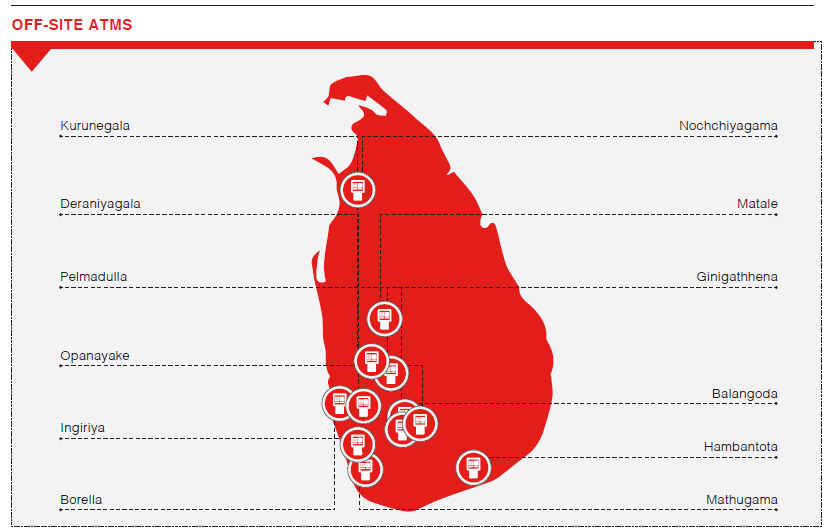

SME Banking
In Sri Lanka, as in many developing and emerging economies, small and medium enterprises are the backbone of the economy and their role is vital to jump-starting the economy. Recognizing this, the Bank has from its inception responded to the needs of the SME sector by giving adequate credit.
Strategic Focus
Strategic decisions have been taken to drive the SME banking with a mindset change. The recent retail and SME integration at all branches, promotes aggressive cross-selling. The changes combine wider distribution/delivery of SME products with centralized processing to reap the economies of scale – which are fundamentals to building a successful and sustainable SME business proposition in the Bank.
Performance
Aligned with national priorities, in the year under review the Bank has extended financial assistance to projects in the key growth sub sectors covering tourism, construction, agriculture, manufacturing and the service sector. Taking into account the anticipated growth levels in the tourism industry, the Bank has geared up to face the anticipated demand for infrastructure development. A large number of SME hotel projects in all regions of the country, including in the Northern and the Eastern provinces, have been assisted. Financing has included both capital expenditure and working capital needs.
SME Asset Growth
SME – KPIs
|
2016 |
2015 |
YoY Change |
| KPI |
LKR million |
LKR million |
% |
| Total operating income |
1,395 |
1,319 |
6 |
| Profit before tax |
576 |
640 |
-10 |
| Profit after tax |
324 |
384 |
-16 |
| Non-performing loans |
1,544 |
1,080 |
43 |
| Cost to income ratio |
46.2% |
36.5% |
– |
| Total loans and receivables |
43,472 |
29,443 |
48 |

Further the Bank has extensively disbursed the available Credit Lines (at concessionary rates) namely, SMILE III and ADB Funding lines mainly to meet the infrastructure development and working capital requirements of the SME sector.
Outlook
The Bank has well identified the dynamics of SME and involves in designing new and innovative approaches for reaching SMEs. Specially designing appropriate products for SMEs and training bank staff to respond to SME needs. The diversity of available financial products is the strength and understanding dynamics help the Bank to give right advice and the right plan at each stage of an SME's life cycle to supports the future success of any SME business.
The Bank will aggressively focus on the growth sectors specially construction, tourism, agriculture service sector and Manufacturing. Special focus will be given to extend the support to exporters of the country which is vital for the country economy.

Micro Finance
Micro finance has emerged in recent times as a major strategy of grassroots development, in emerging and developing economies. The Bank continues to be supportive of micro finance not only for commercial benefit but also for the social value it can generate.
Strategic Focus
During the year micro finance continued its momentum with emphasis on credit quality and risk mitigation. Through the businesses generated by micro finance we empower women and youth, foster environment friendly businesses and otherwise contribute to the country’s development goals. We also strengthened the marginalized section of the economy through non-financial services such as improving financial literacy, management and technical skills training and market linkages. Funding caters to numerous needs ranging from business start-ups, expansions, assets building, working capital requirements and agriculture.
Performance
As at end December 2016, the portfolio stood at LKR 328.4 million. Covering 2,334 numbers of clients. Females continued to account for 60% of the micro finance clients. With the passion, commitment and hard work of the staff a YoY growth of 35.4% in the total outstanding loan book has been achieved.
Sector Dispersion and Geographic Dispersion of the portfolio are illustrated below.
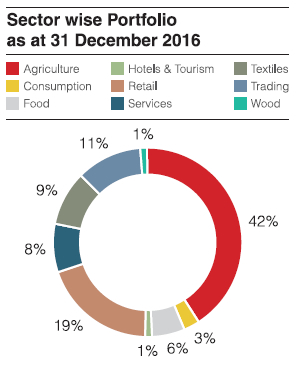
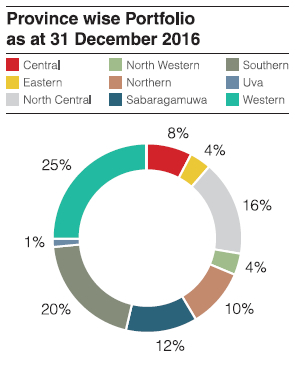
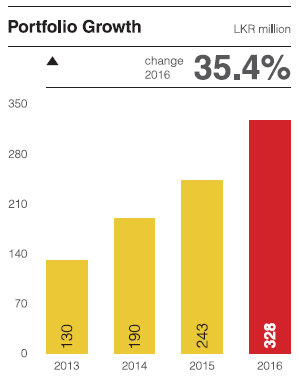
The Bank's Micro finance is connected to rural and marginalized sector through various channels. During the year the Bank commenced the following new channels which recorded highest repayments.
01. Lending through Community Based Organizations
The Bank reaches the bottom of pyramid clients through their societies. The Bank lends in bulk to community based organizations which in turn provide credit facilities to their members.
02. Cluster Based Lending
The Bank has adopted the cluster based approach model which is currently being commonly used by micro finance practitioners. Comprehensive assessments and regular follow ups are conducted in order to ensure proper use of loan funds.
The following examples paint a broad picture of the social and economic impact we are creating through our micro finance lending:
a. The Garment Industry is one of the Largest Export Industries in Sri Lanka
The industry unfortunately largely conforms to the stereotypes associated with globalization in manufacturing: low wages and 'flexible' contracts. Most of the workers in this sector are vulnerable, being young, poor, unmarried and having low literacy levels. Many of them continue to be breadwinners of their natal household and send a significant percentage of their earnings back to their rural families. At financial literacy trainings, it has been unearthed that young female garment workers have a poor ability to manage money and exercise control over their own income. To help them surmount the obstacles that they face, the Bank has tailor-made financial literacy programmes; it also provides micro finance loans at affordable fees and conditions to procure personal needs particularly for renovation of their rural homes.
b. Promote Export Agriculture
The export agricultural sector is also provided assistance by enabling them to add value to their products and acquire new technological innovations. The Bank is improving the capacity of growers to meet international food safety and hygiene standards and in the process is boosting the export capabilities of the country. This project is being done in collaboration with the Export Agriculture Department. Further, the Bank provides financial support at concessionary interest rates to adopt best practice and international standards of food handling.
c. Encouraging Organic Seed Paddy Cultivation
Another very socially beneficial micro finance initiative is encouraging organic seed paddy farming in Polonnaruwa through our financial services. The organic seeds provided have been highly praised and identified as a national requirement. The Department of Agriculture is collaborating the project and provides guidance for the cleaning and processing of seeds. Financial services were provided to purchase machinery and for cultivation.
d. Continuous Assistance to Empower Rural Entrepreneurs
Another initiative which has been implemented with Citi Bank and the Ceylon Chamber of Commerce as partners, seeks to promote entrepreneurship at the bottom of the pyramid by connecting with underdeveloped settlements in Dadayamkanda, Embilipitiya. This programme endeavours to bring a banking culture to communities which had no exposure to banking whatsoever hitherto.
Outlook
The micro finance initiative of the Bank has been two fold, i.e. Provision of credit and advances directly aimed at livelihood development under ’Divi Aruna‘ and Empowerment and capacity building initiatives targeted at financial inclusion.
The ’Divi Aruna‘ initiative is aimed at developing livelihood for prospective entrepreneurs who are not within the mainstream of banking. The philosophy also underlies the thinking that, in the economic resurgence that will generate many growth opportunities, with industries like fisheries, agriculture and infrastructure development poised to take off, the improvised and marginalized individuals in the rural sector would miss out, if not given a helping hand at inception. This scheme, which was initiated in June 2010 in the north and the east subsequently expanded to cover other parts of the country synonymous with branch openings and other expansion initiatives.
With the experience gained in engaging the micro finance sector since 2010 the Bank intends to leverage such experiences and systematically grow its business dealings with identified micro finance segments.
In addition, the Bank also aims to promote a savings culture, and to bring the marginalized and the forgotten into the banking stream. The scheme gives the option of saving a specified sum monthly, giving them the confidence to enter the mainstream of banking with value additions such as ATM cards thereby instilling in them a sense of belonging to the community.
Success Story
“I started with very little, but I always try to build on what I know ...”
- S H Sri Jayantha, Badanagala.
S H Sri Jayantha is a man with ‘success story’ written all over him. His hard work and diverse innovative ideas in blacksmith industry have made him one of the most successful entrepreneurs in Polonnaruwa District. He is the pioneer in blacksmith industry in Polonnaruwa and farmers trust his agricultural tools. “Last year, in the Light Engineering division I was awarded the first place in the North Central Province and the third place all-island. As the manual process to heat the steel for forging is a difficult process I had a desire to manufacture an electrical machine for steel forging.
For this purpose I obtained a loan of LKR 500,000 from the NDB Branch office at Kaduruwela. Having repaid this loan, I was able to obtain a further loan of LKR 500,000 to enable me to manufacture forging machines.”
“ A Street Food Vendor at Galle Face Green became a Canteen owner who provides three meals per day for 135 workers.”
- Mrs. Ishari Maduwanthi
Ishari was a street food vendor who commenced her business with one mobile cart at Galle Face Green. A Diviaruna micro finance loan from NDB Bank enabled her to expand to a second mobile cart. With her second loan of LKR 30,000, she purchased yet another mobile cart and developed her finger food business. Ishari’s next target was to own a small hotel and move from Galle Face Green. With her 3rd loan, in the year 2016, she was able to acquire the canteen of a multinational construction company, having 135 residential employees. Ishari is providing all three meals for them and her average sales turn over recorded LKR 1.6 million per month. Presently she has created employment opportunities for seven people. “The NDB bank is helping small entrepreneurs like us to build up our businesses. The Bank makes things easy for us, by enabling us to obtain loans quickly and without property bonds. We can also get loans using only two guarantors. I am sure that NDB Bank will continue to help me in the future.”

Refinance Operations
Strategic Focus
Source of finance is a pivotal capital decision when the investors embark on scaling up of their current operations and the concessionary funding schemes get prime attention in this context. The Bank’s refinance operations claim a proud legacy and a strong reputation which has left its financial footprint over countless projects across the country creating millions of employment opportunities across its dual role as an apex body as well as a Participating Financial Institution (PFI) for Credit Lines.
During the year 2016, in the context of rising exchange rates, there was great eagerness across the entire range of borrowers to approach concessionary funding schemes. The Bank continued its financial assistance through its network, extending term loan facilities at concessionary rates under its refinancing window and operated the schemes shown below in its role as PFI.
Performance
| Name of the Scheme |
Project Management Unit |
Sponsor |
Value of Loans
Disbursed
(LKR million) |
No. of
Loans |
| Saubhagya |
Central Bank ofSri Lanka |
Central Bank of Sri Lanka |
81 |
44 |
| Small and Medium Enterprises Line of Credit (SMELOC) |
Ministry of Finance & Planning |
Asian Development Bank |
1,821 |
160 |
| Working capital loan for Registered Tea Factories |
Central Bank of Sri Lanka |
Ministry of Finance & Planning |
802 |
14 |
| New Comprehensive Rural Credit Scheme (NCRCS) |
Central Bank of Sri Lanka |
Ministry of Finance & Planning |
26 |
101 |
| SMILE II Revolving |
Ministry of Industry & Commerce |
Japan International Co-operation Agency (JICA) |
911 |
92 |
|
|
|
3,641 |
411 |
SMILE III Revolving Fund
At present under the SMILE III Revolving Fund, ten Financial Institutions act as PFIs and the Bank granted 92 facilities during 2016.
Total disbursements by NDB as at the end of the year was LKR 1.02 billion. This represents 10.4% market share of the SMILE III Revolving Fund which stands LKR 9.8 billion. Currently, NDB is ranked First place among all PFIs for the SMILE III Revolving Fund.
USD 100 Million Small & Medium Enterprises Line of Credit (SMELOC)
This credit line was sponsored by the Asian Development Bank to assist the small and medium enterprises in Sri Lanka and channelled through the Ministry of Finance & Planning. The credit line was officially launched in March 2016, and 10 financial institutions including the Bank, partnered the scheme as PFIs. Credit line introduced a novel concept to Sri Lanka, where the PFIs are required to bid for the borrowing cost to win the fund at an online auction platform. The Bank emerged the winner of the first auction out of eight scheduled and was awarded USD 12.5 million (LKR 1,821 million). The Bank granted 160 facilities using the funds out of which 19 facilities were granted to women led enterprises and another 24 facilities were granted to first time borrowers on start up projects; these two segments illustrate the social and economic impact of the Bank through the credit line.
Tea Factories Loan Scheme
To mitigate the financial problems the Registered Tea Factories (RTF) were facing, the CBSL launched the loan scheme to help them meet their obligations in spite of the declining prices at the tea auctions during 2016. The Bank, which has long standing links with the tea industry made its contribution to this national effort by assisting 14 tea factories. The Bank released facilities up to LKR 802 million at concessionary rates jointly with the Central Bank of Sri Lanka.
Outlook
Stemming from the strategic importance of increasing its customer base by granting concessionary loans, in 2016, the Bank increased its refinance portfolio approximately by three folds over the previous year and continues its focus to promote more concessionary funding schemes in 2017. The Bank wishes to partner ‘Swashakthi’ Micro Finance Credit scheme of the Government of Sri Lanka, an initiative to create 25,000 new self-employment projects by granting loan facilities worth LKR 200,000 and a grant of LKR 50,000 sponsored by the Finance Ministry. The Bank also wishes to partner Ministry of Industry and Commerce in its E-Friends Revolving II Loan scheme to be launched this year sponsored by JICA. The Bank will also join ‘Kapruka’ loan scheme of the Coconut Development Board to promote coconut cultivation. Above schemes would back the growth of SME financing and widening of Micro Financing Operations of the Bank to reach its intended growth magnitude. Finally Refinance operations steer its best effort to enhance reputation as a best Participating Financial Institution among external institutional stake holders leading new Re-financing partnerships in achieving sustainable growth prospects of the Bank.

Islamic Banking
Strategic focus
Islamic banking also referred to as NDB - Shareek is an area that has contributed towards the Bank's bottom line while simultaneously building of social capital during its short tenure of engagement.
Offering of Sharia Compliant products such as Ijarah, Murabahah, Diminishing Musharakahah and Mudarabah for the retail sector have proved to be very popular resulting in 25% of the Islamic Banking portfolio being in the retail sector.
Performance
Despite the volatile markets in the conventional markets in the interest rates as well as the exchange rates NDB – Shareek achieved a commendable performance during the year recording positive growth in deposits and advances while maintaining an extremely low NPL position for the sector.
The success of our Islamic Banking facilities is demonstrated by an important accolade; NDB – Shareek was adjudged as the Best Emerging Islamic Finance Entity of the Year 2015, by Islamic Finance Forum of South Asia and received the Gold Award.
Given our extensive network covering all areas of the country and our comprehensive Islamic banking products and services, the portfolio was well-managed and was able to maintain a NPL ratio below 0.01%.
During the year, we have carried out many customer awareness programmers in areas where there is potential.
The motivated and dynamic team of the NDB – Shareek Unit ably carried out the Unit’s vision and strategy to service the customers throughout the Bank’s network who desire Shariah compliant products.
Outlook
Given the extensive network coverage in the country, the comprehensive Corporate, SME and Retail banking products on offer supported by the customer awareness programmes carried out in potential areas and by a committed and knowledgeable team NDB – Shareek possesses the capability of expanding in the years ahead.

Treasury
Market Position
During the second half of 2016 the macroeconomic focus was on building economic momentum and bettering investor perceptions about the country. These hopes were bolstered by the USD 1.5 billion funding pledge from the IMF in June and a USD 1.5 billion dual tranche sovereign bond issue in July. The IMFs Extended Fund Facility (EFF) gave an impetus for increased foreign flows into the debt and equity markets so much so that the Central Bank of Sri Lanka decided not to re-issue two Sri Lanka Development Bond maturities during the second half of 2016. However, the EFF imposed conditions on the country to keep to a promised programme of fiscal reforms. In addition the slowing of economic growth in China, which has detrimental impact on exchange earnings and the lackluster global economic performance, were additional hurdles the country had to face. In mid-February, Fitch downgraded Sri Lanka's long-term foreign and local currency issuer default ratings to B(+) from BB(-) with a negative outlook, citing concerns over increased refinancing risks. However the Country continued its efforts to reach EFF compliance with efforts to broaden the tax base and increasing the value added tax form 11% to 15%, while bringing a broader range of items into the net. Two severe droughts during early and late 2016 and a devastating flood which affected much of the Western Province trading hub in Colombo had a very adverse impact on the economic growth.
With the objective of curtailing above average private sector credit growth the Central Bank of Sri Lanka moved to tighten credit, by raising benchmark rates by 50 basis points in February and July. Consequently, short-term rates were adjusted upward, with money market rates and benchmark weighted prime lending rates rising throughout the year. The Dollar exchange rate which fluctuated between LKR 145 to 148 for most of 2016, ended the year at LKR 149.80 recording a depreciation of 3.80% for the year. The above mentioned factors contributed to the Rupee depreciation.
Performance
The fluctuations in exchange rates gave an opportunity, which if exploited judiciously, opened up opportunities for foreign exchange trading gains. Exporters and importers sought to gain advantage of the peaks and the troughs to book forward and minimize exposure. The Bank continued to capitalize on its strengths as a dominant market maker providing a range of foreign currency related products such as plain vanilla FX forwards, FX derivatives, dual currency deposits, FX options and FX swaps to the entire spectrum of corporate, retail and interbank clients. The Bank exploited all possible opportunities to reap the fruits of the dynamic market situation.
Buoyed by volatility in both the local USD/LKR as well as the international cross currency market, the FX desk achieved sizeable trading gains recording a trading profit of LKR 645 million, despite the restrictions imposed by the Central Bank of Sri Lanka. Through good customer orientation and building on new relationships the Sales desk also achieved a record revenue of LKR 333 million.
Asset & Liability Management
There was intense competition in the interbank market to accumulate deposits to fuel above average credit growth. With the deposit rates continually rising throughout 2016, the Asset & Liability Management (ALM) desk focused on supporting the Bank’s credit growth amidst a price war. Despite considerable fluctuations during the year in the Government security yield curve, the overall yields movement during the year was upwards. With this background, the ALM unit was able to achieve moderate trading gains, managing the market risk to optimize revenue.
Outlook
The budget proposal to remove the notional tax credit available on Government security investments and increasing the withholding tax from 10% to 14%, created uncertainty in the debt market. Lack of clarity on implementation of the proposals created hesitation among market participants. Federal Reserve raised interest rate by 25 basis points in December which raised the threat of a faster pace of tightening in 2017. Against this backdrop the LKR yield curve is expected to creep up during 2017. Emerging markets are expected to suffer Dollar outflows further exerting pressure on reserves and current accounts. The Sri Lanka Rupee is expected to depreciate moderately within the median witnessed over the past years.
The rising yield curve should have a propitious impact on the balance sheet. The gapping process has been optimized to earn maximum revenue in such a scenario. While a volatile environment can be expected in 2017, the FX desk will be capable of handling any adverse situations that may arise through innovative, dynamic and proactive product and pricing solutions.
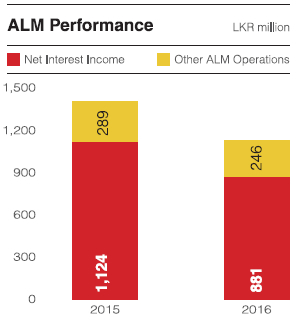
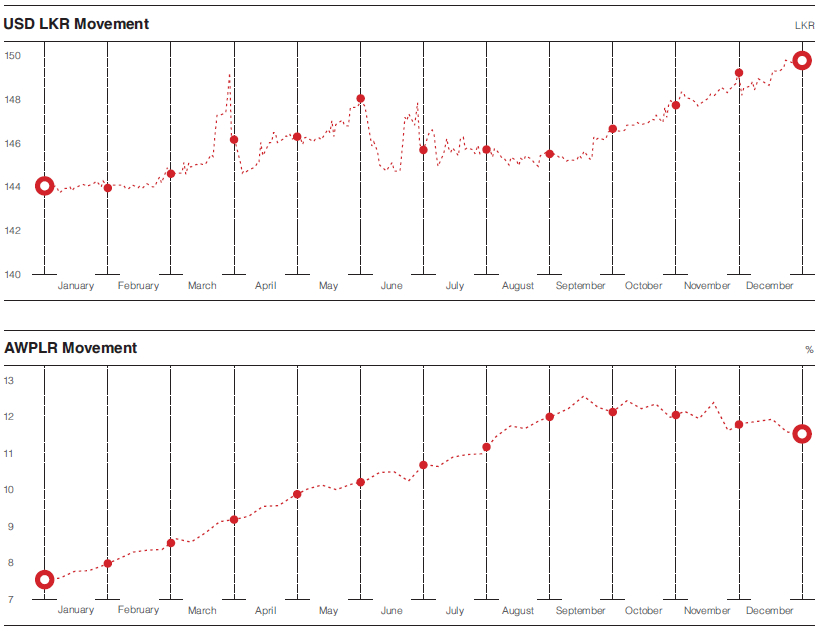
|
2016
LKR million |
2015
LKR million |
YoY Growth
% |
| Other ALM operations |
246 |
289 |
(15) |
| Net interest income |
881 |
1,124 |
(22) |
| Foreign exchange income |
982 |
1,088 |
(10) |
Our capital market cluster plays an industry leader role in the Sri Lankan investment banking sphere. The same is affirmed by the multiple awards which are conferred on our businesses within the cluster.
Performance of Group Companies
The Group comprise of the capital market cluster and a company engaged in property management business.
The Capital Market Cluster
The focus of the capital market cluster of the Group consists of fund based and fee based operations related to investment banking, stock broking, wealth management and private equity management. The cluster endeavours to provide a comprehensive range of investment banking and related services to a wide range of clients, both corporate and individual. With a rapidly changing socio-economic environment and competition, constant innovation to keep abreast becomes imperative.
The investment banking cluster of the Group comprised of the following:
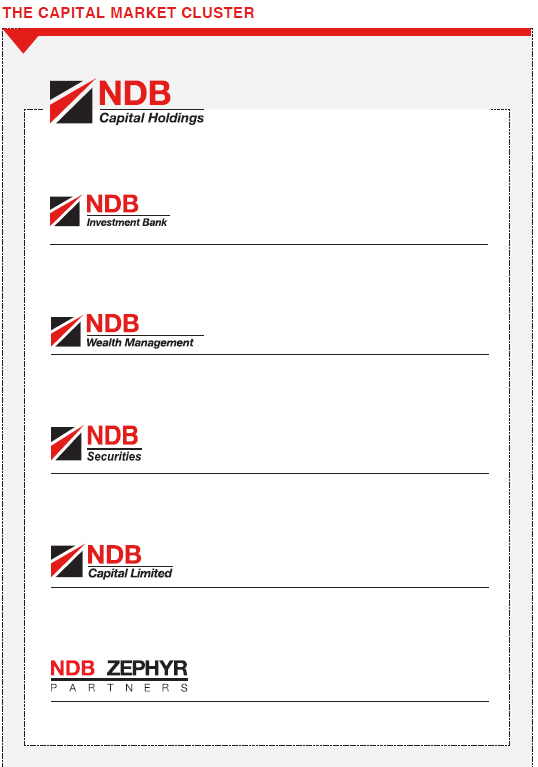

NDB Capital Holdings Ltd.
Strategic Focus
The unique strengths and skills of the investment banking cluster of the Bank position it well to be the leading full service investment bank in the country. The cluster is involved in a wide range of activities including fund based and fee based investment banking (both in Sri Lanka and Bangladesh), asset management, stock brokering and private equity management. The services provided by the Capital Market Cluster has facilitated the Group to be one of the leading integrated financial service providers in the country, with a diversified product and service portfolio spanning both commercial banking and investment banking spheres.
Performance
NDB Capital Holdings Ltd. formerly known as Capital Development and Investment Company PLC (CDIC), was formed in 1983 as a venture capital company. CDIC was subsequently listed on the Main Board of the Colombo Stock Exchange in 1996. Following a restructuring within the Group in mid-2012, CDIC was transformed into a full service investment bank and rebranded as NDB Capital Holdings Ltd. (NCAP).
NCAP and its subsidiaries (collectively referred to as the investment banking cluster or NCAP Group) are strategically positioned to play a key role in the economic development and growth of the capital market of Sri Lanka. NCAP is involved in both fee based operations as well as fund based operations. While the main fee based operations of the company are carried out through its subsidiaries, NDB Investment Bank Ltd. (NDBIB), NDB Wealth Management Ltd. (NWM), NDB Securities (Pvt) Ltd. (NDBS) and NDB Zephyr Partners Ltd. (NDBZ), NCAP directly participates in fund based operations including but not limited to investments in listed equities, private equity, fixed income securities and structured products.
Business Line Performance
Despite an improvement over the uncertain political climate that prevailed in 2015, local market conditions remained lackluster in 2016. The average daily market turnover of the share market dropped from LKR 1,060 million by the end of 2015 to LKR 743 million by the end of 2016 marking a drop of approximately 30% over the period under review. While NDBS absorbed the direct impact of this drop in market activities, NCAP managed to minimize any losses from its short/medium-term equity portfolios owing to timely changes in the asset allocation decision.
NCAP has not confined itself to commercial activities but has also ventured into CSR activities. An important initiative in this regard is the NDB Capital Scholarship Trust Fund which was launched in 2014. The recipients for this programme are selected through a transparent and conscious process. A number of criteria are considered including financial needs, academic prowess, extracurricular activities and leadership skills. Thus far, 32 scholarships have been awarded to students from local universities. A total service is offered to the students, including career counselling, career development opportunities and internships. ‘Be the best you were born to be’ by Dhammika Kalapuge is one of such training programmes conducted by the Trust for scholarship recipients in March 2016.
Financial Performance
The Capital Market cluster recorded a consolidated profit after tax of LKR 519 million by the end of 2016.
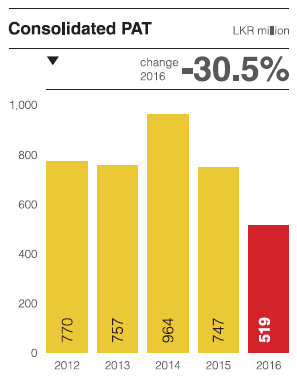
Note: The 2012 profit and net asset value have been adjusted for the one-off capital gain reported from divestiture of AIA Insurance, while that of 2013 is adjusted for the impact on profits due to investment income earned from the aforesaid capital gain due to the divestiture of AIA.
| KPI |
2016 |
2015 |
YoY
Change
% |
| Total operating income (LKR million) |
1,182 |
1,513 |
(22) |
| Profit after tax (LKR million) |
519 |
747 |
(31) |
| Return on equity (%) |
9.0 |
11.8 |
(24) |
| Operating profit margin (%) |
49.0 |
55.0 |
(11) |
| Net profit margin (%) |
44.0 |
49.0 |
(10) |
Outlook
The Capital Market cluster will concentrate on achieving and maintaining the leadership position in investment banking, asset management as well as private equity management and will focus on being the driving force for capital market development in Sri Lanka.

NDB Investment Bank Ltd.
Strategic Focus
NDBIB is the investment banking arm of the Group offering fee based services ranging from debt and equity raising, corporate advisory services to mergers and acquisitions. Over the years, NDBIB has cemented its position as the market leader for both debt and equity transactions in Sri Lanka.
Performance
NDBIB reaffirmed its supremacy in the capital market by successfully raising LKR 47.6 billion primarily through a combination of debentures, securitizations, long-term debt facilities and equity. As in 2015, NDBIB once again retained its a leadership position with a market share of 37.4% in the listed debenture space, outperforming its competition. Furthermore, NDBIB was crowned “Sri Lanka’s Best Investment Bank” in 2016 for the fifth consecutive year by the prestigious Euromoney Magazine.
Some of the key transactions executed during the year include the following:
- NDBIB successfully raised LKR 31.5 billion in listed debentures. The debentures raised were predominantly in the banking and finance sector which included Hatton National Bank PLC, Sampath Bank PLC, Siyapatha Finance PLC, People's Leasing and Finance PLC and Singer (Sri Lanka) PLC
- NDBIB acted as the financial advisor for a group restructuring of the Silvermill Group of Companies, enabling the group to segregate its overall strategy and investment decisions from that of operational and tactical levels
- As financial advisor, NDBIB carried out a group valuation exercise and recommended suitable mechanisms for a proposed restructuring within the Citrus Group, with the aim of unlocking shareholder value
- NDBIB acted as financial advisor to Mobitel in its acquisition of E-Channelling, its maiden acquisition and entry in to the fast growing e-healthcare space. The acquisition was structured by NDBIB who subsequently managed the voluntary offer by Mobitel to the shareholders of E-Channelling
- NDBIB’s expertise was sought once again by Sanasa Development Bank PLC on a fund raising that comprised equity, convertible debt and senior debt. Two multi-lateral agencies and a foreign fund have committed to participate in the fund raising of approximately USD 20 million. NDBIB also acted as the financial advisor for a scrip dividend issue of the Bank
- NDBIB was mandated to carry out several independent valuations of companies operating in sectors such as financial services, education, leisure, healthcare etc.
- NDBIB acted as financial advisor and arranger to the structured loan facility of LKR 4.0 billion raised for the LAUGFS Group with the participation of NDB. The facility was for a total tenure of eight years and was raised via different tranches
- NDBIB advised and acted as manager to the Share Repurchases to be carried out by four companies belonging to the Carson Cumberbatch Group, namely, Goodhope PLC, Selinsing PLC, Shalimar PLC and Indo-Malay PLC which amounted to a total of over LKR 13 billion
- NDBIB acted as financial advisor for the de-listing of Equity One PLC and subsequently acted as the manager to the exit offer made by Carsons Cumberbatch PLC to the shareholders of the company
NDBIB – Key Performance Indicators
| KPI |
2016
|
2015 |
YoY
Change
(%) |
| Funds raised (LKR billion) |
47.60 |
59.37 |
-19.82 |
| Profit after tax (LKR million) |
122.84 |
123.81 |
-0.01 |
| Operating profit margin (%) |
53.38 |
48.85 |
|
| Net profit margin (%) |
43.31 |
39.90 |
|
| Return on equity (%) |
18.98 |
22.01 |
|
Outlook
With the unveiling of the country’s strategic direction, we expect the political stability envisioned in 2016 to materialise in the forthcoming year. The Government’s implementation of the Megapolis Master Plan, envisaged listing of state-owned entities and possible raising of debt with various instruments will provide an opportunity for NDBIB to venture into transactions that have the potential to attract larger foreign investors. The heightened interest by foreign investors is expected to create the much needed momentum in the local debt and equity capital market which would enable NDBIB to continue its dominance. NDBIB also expects to leverage on its expertise both in equity and debt space and secure assignments in the region, especially in the Maldives and Bangladesh, in a bid to further enhance its footprint outside Sri Lanka. The core competence of NDBIB remains with its dedicated and innovative staff who are geared to accept the upcoming challenges in 2017.

NDB Wealth Management Ltd.
NDB Wealth Management maintained its leadership position in the wealth management business, in Sri Lanka, in 2016. The true testament of leadership in the business of asset management is the number of clients and the funds under management. At the end of 2016, NDB Wealth had over 6,000 clients and LKR 73.6 billion client funds under management. The capital of LKR 758 million versus the regulatory minimum capital of LKR 25 million indicates the strength of the company and the Group’s commitment to the business of wealth management.
The year 2016 was a difficult year, for wealth managers, given the uncertain policy and tax regime. The volatility in the capital and the money market locally was further exacerbated by global factors such as the slowdown in the growth of China, perception of increased credit risks in emerging markets, the Brexit, and the speculation of an interest rate hike in the U.S.A. Moreover, the negative liquidity position in the money market, in Sri Lanka, pushed up interest rates leading to large redemptions by corporate clients. The reduction in the liquidity position in the Sri Lanka Money Market from around a positive LKR 300 billion to a negative of around LKR 50 billion is an indication of the severity of the problem and its systemic impact.
However, NDB Wealth’s research driven investment philosophy has helped our retail clients to broadly steer clear of the volatility.
Strategic Focus
NDB Wealth continued to offer three distinct services: Discretionary Portfolio Management focused on large institutions such as insurance companies, provident funds and corporates, private wealth management catering to high net worth individuals coupled with a series of risk rated mutual funds to meet the wealth planning needs of the retail mass affluent market. Given the market dynamics and demand, NDB Wealth focused on developing its retail business in 2016. To this end the launch of a new mutual fund, the ’NDB Wealth Income Plus‘ was a success and helped clients lock in their funds with a target rate set for a year.
Also, NDB Wealth sponsored the 'NDB Wealth Junior Masters Golf Tournament', a yearly event, encouraging kids to play golf. This event is probably the most sought after junior golf tournament in Sri Lanka, given the record number of participants it had both local and international. The NDB Wealth has taken a further step in promoting junior golf by being the sponsor for the 'Junior Golf Ranking System' conducted by the Sri Lanka Golf Union. To coincide with the Junior Golf Tournament NDB Wealth launched a series of wealth plans for kids, a savings plan – the 'KIDS Saver' and an investment plan – the ‘KIDS Saver Plus’. Further, the Group introduced a unique financial product to the Sri Lanka market, the ‘ONE Account’ which combines a current account, a credit card and a Money Market investment account, which converges banking and capital markets. We believe the ‘ONE Account’ will be a trend setter in Sri Lanka as a product and with new and exciting features being continuously added to provide our clients truly cutting edge banking and wealth management.
Performance
| KPI |
2016 |
2015 |
YoY
Change
(%) |
| Assets under management (LKR billion) |
73.61 |
92.84 |
-21 |
| Profit after tax (LKR million) |
111.31 |
157.27 |
-29 |
| Return on equity (%) |
16 |
26 |
|
Despite the challenging market conditions in year 2016, NDB Wealth posted a profit after tax of LKR 111.3 million for the year ended 31 December 2016. However, PAT has exhibited a decline of 29% in comparison to 2015 mainly due to the decrease in total fee based income from corporates. There was a healthy growth of 52% in investment income over the comparative period due to the increase in the interest rates which compensated the decline in the fee income.
Total assets under management (AUM) declined by 21% to LKR 73.6 billion owing to the withdrawal of funds by institutional investors from the mutual funds during the year; the reasons for which are explained in the preceding section.
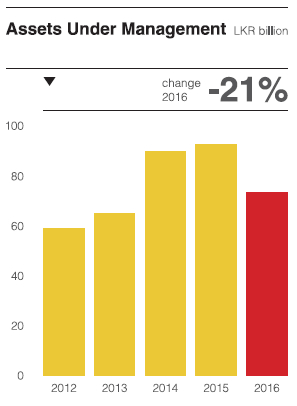
Outlook
Going forward the uncertainty in the tax regime, the low level of liquidity in the money markets, and inconsistent policy may pose challenges in acquiring corporate clients. However, the low level of liquidity and increasing rate of inflation is expected to keep interest rates high which will afford attractive returns to new and existing investors in the fixed income funds managed by NDB Wealth.
Our investment advisory
and securities tradings
entity, NDB Securities
(Pvt) Ltd., emerged as
the Best Stockbroker
Research Team in 2016,
at the CFA Sri Lanka
Capital Market Awards.

NDB Securities (Pvt) Ltd.
Strategic Focus
NDB Securities (NDBS) main business objective is to provide a platform to its strong institutional and retail client base to access the capital market space in Sri Lanka through its listed equity and debt trading platform. NDBS's offerings in this space are topped up with a number of related value added services including state-of-the-art online trading facilities for speedy trade executions, margin trading and other credit facilities through its parent NDB and comprehensive coverage of research to support trading activities. As a short-term objective, the company whilst providing other fee based services has the goal of becoming the premier stock broking company in the country. Further, NDBS is currently working on setting up the platform to embrace the strong integration of Sri Lanka and global investment giants.
Performance
2016 has been a dismal year for the Sri Lankan stock market. The average daily turnover of CSE plummeted 30.4% from LKR 1.06 billion in 2015 to LKR 0.74 billion in 2016. This has had an adverse impact on NDBS performance with the company recording a marginal loss. However, NDBS was successful in maintaining its equity market share at 4.16%. The company’s strong capitalization and stringent risk management strategy aided towards successfully driving the company forward amidst the downturn in the sector.
Despite adverse circumstances, NDBS continued its expansion by continuing to recruit staff as well as not stinting on further training and development of staff. NDBS systems have been continuously updated and evolved enabling it to differentiate itself from the competition. The company further expanded their IT Department by upgrading their servers and systems to the latest technology. Further, the research arm expanded its services and grew at a rapid pace. Their extensive research reports are read and used by many industry experts both locally and internationally. They were awarded the Gold as the Best Stock broking Research Team at the CFA Sri Lanka Capital Market Awards 2016.
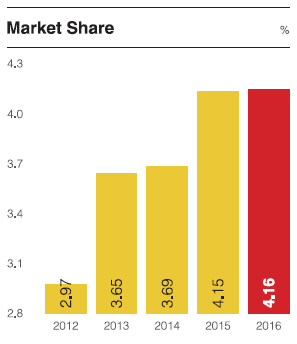
Outlook
NDBS takes pride in its business model as a total financial services provider through the group strength which positions it to stand out among the competition. Further, the company is in the process of finalizing strategic partnerships that will further enhance its growth by creating synergies with leading multinationals globally. Towards the first half of 2017, NDB Securities, NDB Investment Bank and NDB Wealth Management will come under one roof which will additionally increase the ease for their clients to do business.
Moreover, we expect the capital market to become more broad based and vibrant in the future to support Sri Lanka’s expected sustainable economic growth. NDBS is fully equipped to enter the next phase of growth in the capital markets of Sri Lanka whilst achieving the goal of becoming the leading brokerage house in the country.

NDB Capital Ltd. (Bangladesh)
Strategic Focus
The main thrust of NDB Capital Ltd. (NDB Capital), the investment banking arm of the Group in Bangladesh, in 2016 was infrastructure. Bangladesh has been showing strong growth performance with a GDP growth rate of 6%-7%. The economy, however, has to overcome a number of economic bottlenecks to achieve higher GDP growth rate. The inadequacy in infrastructure, which is currently insufficient to keep pace with the growing economy, is one of these major challenges. The Government, realizing this need, has come up with several infrastructure and LNG projects to lay the foundation for the sustainable economic welfare that the country aspires to.
Keeping in mind the country’s vision of reaching middle income status by 2021, NDB Capital took mandates predominantly for infrastructural projects (power, port, etc.) and was instrumental in introducing new products to the nascent capital market. Despite a challenging regulatory environment, NDB Capital successfully raised BDT 1 billion through issuance of Redeemable Preference Shares for Summit Barisal Power Ltd. and Summit Narayanganj Power Unit II Ltd., two new power plants of the country’s largest private sector power producer, Summit Group. The Company is also mandated to raise debt & equity of BDT 2 billion for a private sector container terminal port in Chittagong, the country’s port city. NDB Capital was also successful in arranging a strategic equity partner from Sri Lanka to set up a JV NBFI in Bangladesh for the reputed corporates of Bangladesh. This venture helped to bring FDI of about USD 10 million into the country this year. Furthermore, NDB Capital is working to raise equity through an initial public offering for a leading pre-fab steel structure manufacturer. NDB Capital for the first time secured a mandate for raising mid-term funds for a superstore chain through securitization of credit card receivables which will be the first transaction of this kind in Bangladesh.
In addition to raising long-term funds for different projects, NDB Capital raised short-term funds for the top corporates of the country through issuance of commercial papers and more than BDT 12 billion has so far been raised in 2016, though this is a relatively new money market instrument. Since the completion time for such deals is less, a constant flow of revenue was ensured in the first half of the year. In addition, NDB Capital also earned foreign currency revenue in this year too through its overseas corporate advisory services.
Performance
While NDB Capital won quite a number of mandates, unfortunately the high yielding ones could not be completed within the year due to the depressed overall private sector investment mood in the second half of the year. As a result, the company managed to record a revenue of slightly over BDT 30 million only. The company incurred aloss of BDT 18 million. The KPIs are graphically represented.
It should be noted here that NDB Capital has won the prestigious Euromoney award as the Best Investment Bank in Bangladesh in 2016 in recognition of its innovation and structuring of capital market products, which is making a significant contribution to the development of the country’s capital market.
Outlook
It is expected that the present excess liquidity in the banking system will last for a few more years, which will pave the way for increased investment especially in the public sector along with the stable capital market condition. With the huge financial commitments from the neighbouring countries mainly in the infrastructure and energy projects in the public sectors, strong macroeconomic fundamentals and political stability, the near term prospects seem to be encouraging. Having secured mandates for innovative deals and boasting a robust pipeline, NDB Capital is expected to build on the synergies with its parent in order to contribute to the Group’s profitability in the coming years.

NDB Zephyr Partners Ltd. (Mauritius)
Strategic Focus
NDB Zephyr is the Fund Manager of Emerald Sri Lanka Fund which places private equity investments in Sri Lanka based small and mid-sized businesses, seeking capital for expansion. NDB Zephyr Partners Ltd. (NDB Zephyr) is jointly owned by NDB Capital Holdings Ltd. (NCAP) (60%) and Zephyr Management, LP (Zephyr) (40%), a New York-based global emerging markets investment firm. Emerald Sri Lanka Fund is a Sri Lanka dedicated Private Equity Fund and the investors of the Fund include reputed institutions such as IFC, a member of the World Bank Group, DEG- German Development Finance Corporation, FMO (the Netherlands Development Finance Company) along with NDB Capital Holdings Ltd.
The current socio-economic, demographic and political climate as well as the composition of the labour force in Sri Lanka provides an environment conducive for the growth of small and medium-sized companies. NDB Zephyr has identified certain barriers that SMEs face, such as lack of collaterals which limit its access to traditional bank finance and hence hinder the growth after a certain point of evolution. Furthermore, Sri Lankan SMEs currently have limited equity raising options until an IPO, and many SMEs are not ready for an IPO, due to their small size, deficiency in management and lack of best practices of corporate governance.
The Emerald investment team draws on expertise from Zephyr Management regarding the investment process, including deal evaluation, portfolio management and exit management. The Emerald team assists its portfolio of companies in several dimensions such as strategic planning, management development, effective financial management, corporate governance and improving efficiencies in addition to providing equity capital which would lead to realization of anticipated growth potential. The investment team will also help the portfolio companies in accessing international markets and optimizing their capital structures through the wide network they have access to. NDB Zephyr will draw on the capabilities and experience of the parent companies, NDB Capital Holdings Ltd. and Zephyr. The Fund’s investment team will benefit from NDB Capital’s profound understanding and experience in the Sri Lankan market.
NDB Zephyr analyses and carries out sector research to select companies which have a unique value proposition and a sustainable growth potential, through a scrupulous due diligence process. Exits will be generated via IPOs or through trade sales to domestic or international buyers.
Performance
During 2016, Emerald Sri Lanka Fund invested LKR 158 million in Cleanline Linen Management (Pvt) Ltd. (CLM), a centralized laundry services provider to star class hotels in Sri Lanka. CLM, as a part of its value proposition, adopts sustainable environmental practices by implementing energy and water conservation methods and efficient waste management systems.
The Emerald Sri Lanka Fund also invested LKR 580 million in JAT Holdings (Pvt) Ltd. (JAT), the market leader in water-based wood coatings sector in Sri Lanka. JAT has exclusive rights to manufacture and distribute one of the world’s leading wood coating brands, Sayerlack, across Sri Lanka, India, Bangladesh, Maldives, Pakistan and Seychelles. In 2014, JAT established a partnership with Crown Paints U.K. to manufacture and sell premium emulsion brands, Crown and Permoglaze. In addition to lacquers and paints, JAT also distributes many well-known brands of wood treatment solutions, wood fillers, sandpapers and abrasives, paint brushes, office furniture, flooring and ceiling products.
Financial performance of the company during the year ended 31 December 2016: (in USD 000's) is as given below:
|
2016 |
| Turnover |
850 |
| PBT |
226 |
| PAT |
221 |
| ROE (%) |
33 |
Outlook
NDB Zephyr is continuously seeking attractive companies to invest in, therefore discussions are ongoing for more investments in the future. The team is currently having discussions with a range of companies in the sectors such as financial services, leisure, healthcare, information technology and FMCG. Furthermore, the team’s knowledge acquired through active participation in local and international transactions will benefit the company in selecting attractive investments which will enhance shareholder returns.
Property Management

Development Holdings (Pvt) Ltd.
Strategic Focus
Development Holdings (Pvt) Ltd. (DHPL) is the property management entity of the Group with a co-ownership with the Export Development Board (EDB). DHPL owns and maintains the 16 storied high-rise building situated in Navam Mawatha, Colombo 2, popularly known as the NDB-EDB Tower. The strategic focus of DHPL for the year was to enhance its financial performance whilst maintaining high standards/qualities of office premises given the unique locational value of the building.
NDB-EDB Tower is built with ample car park facilities, a fully-fledged auditorium which can host up to 250 people and a cafeteria. All floors of the building are fully occupied. The tenants are reputed global and local entities which make the Tower a miniature business hub of its own. Some of the occupants are the Bank and the Export Development Board themselves, the International Finance Corporation (IFC), Sri Lanka Export Credit Insurance Corporation (SLECIC) and Microsoft Sri Lanka.
Performance
DHPL reported a revenue of LKR 163 million for the financial year 2016, which was a 5% increase over the previous year. DHPL recorded a net profit of LKR 268 million which was a negative 4% growth over 2015.
DHPL is considered as an investment property as per the current accounting standards and the changes to the fair value is accounted for as revenue. Accordingly, the appreciation in the fair value of the building is a clear reflection of the maintenance and operational expenses incurred for the upkeep of the premises. What is noteworthy of DHPL is that, it has managed to exceed the budgets set for income and profit for the year 2016.
| KPI |
2016 |
2015 |
YoY Change |
| Revenue (LKR million) |
163 |
155 |
5% |
| Net profit
(LKR million) |
268 |
277 |
-4% |
| Contribution to Group PAS |
5% |
3.7% |
NA |
Outlook
DHPL has been in service as a commercial property since 1997, for over 20 years. The recognition it has earned as a strategically important commercial property is demonstrated by the caliber of the corporates who have occupied the property.
DHPL’s future orientation lies in further upgrading the property and the amenities offered thereby providing its tenants a strategically advantageous and convenient location for their businesses. DHPL is also geared to upgrade the facilities offered by the auditorium and enhancing revenue via renting out the auditorium around the year.
































